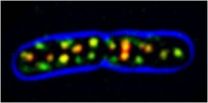(Press-News.org) Almost all bacteria owe their structure to an outer cell wall that interacts closely with the supporting MreB protein inside the cell. As scientists at the Max Planck Institute for Biochemistry and at the French INRA now show, MreB molecules assemble into larger units, but not - as previously believed – into continuous helical structures. The circular movement of these units along the inside of the bacterial envelope is mediated by cell wall synthesis, which in turn requires the support of MreB. This mutual interaction may be a widespread phenomenon among bacteria and opens up new avenues for therapeutic intervention. The bacterial cell wall is already a major target for antibiotics. (Science, June 3, 2011)
Even single cells have to maintain their shape: In higher organisms, the supporting structures of the cytoskeleton, which include filament networks made of the protein actin, take care of this job. The much smaller bacterial cells possess similar cytoskeletal structures, such as the actin related protein MreB. Up to now, scientists believed that this molecule forms spiral structures on the inside of the cell membrane in non-spherical bacteria, which serve as a scaffold for the assembly of the comparatively rigid cell wall.
Using innovative imaging technologies based on fluorescent microscopy, the scientists in the laboratory of Roland Wedlich-Söldner have now been able to show that MreB proteins do not form such highly ordered structures – and yet are organized in more complex ways than they had previously assumed. "MreB molecules assemble into larger units, or patches. They move in circular paths along the inside of the cell membrane, but without following a preferred direction", explains Julia Domínguez-Escobar, PhD student at the Max Planck Institute of Biochemistry.
A highly unexpected finding of the study was that the movement of MreB patches relies on a functioning cell wall. MreB structures cannot move on their own but are pulled along the bacterial envelope by the newly synthesized cell wall material. The MreB patches are located at the inside, the cell wall at the outside of the cell membrane. Thus, interaction is likely mediated by molecules that span the cell membrane. These molecular adapters link the incorporation of newly synthesized cellular material with the MreB units, which thereby follow the permanently growing cell wall structures.
Many parts of the cell wall are almost universally conserved in bacteria, making it likely that the newly discovered mechanism is widespread. Hence, the results could play an important role for the further investigation of bacterial cells, but also for medicine: "Cell wall synthesis already is a key target for antibiotics. New insights into the structure of the cell wall could open up urgently needed therapeutic alternatives", hopes Wedlich-Söldner.
INFORMATION:
Bacterial roundabouts determine cell shape
2011-06-04
ELSE PRESS RELEASES FROM THIS DATE:
Paper and computer workarounds challenge but may improve health IT
2011-06-04
INDIANAPOLIS – A new research study investigates the challenges that pen and paper workarounds or computerized communication breakdowns pose to the use of electronic health records. Understanding these challenges may lead to improved coordination of care supported by health IT.
Focusing on referrals by primary care physicians to specialists and communications from the specialists back to the referring physician, "Paper Persistence, Workarounds, and Communication Breakdowns in Computerized Consultation Management" appears in the July 2011 issue of the International Journal ...
Study finds vaccine extends recurrent GBM survival rates by 2 to 3 times
2011-06-04
In data presented at The American Society of Clinical Oncology (ASCO) Annual Meeting, cancer researchers found that the brain tumor vaccine HSPPC-96 for treating recurrent gliobastoma (GBM) has a favorable safety profile and extends survival by two to three times more than the current median survival rate. Patients in the study, conducted at University Hospitals Case Medical Center, University of California, San Francisco and Columbia University, were found to have a median survival of 11 months compared to current three to five month survival.
"The findings are very ...
MedWOW's Global Medical Eqiupment Platform Strengthens Franchise Team
2011-06-04
Due to increasing international demand, MedWOW greatly expanded its operations by launching a Global Franchise Program. MedWOW's Franchise Program screens qualified medical equipment professionals throughout the world, in order to find the best representatives to join the MedWOW brand and offer the website's services in their defined territory.
The franchise program offers reputable key-players in the medical equipment industry the opportunity to expand their existing business, by giving them the rights to market MedWOW to end-users in their territories, including: ...
Study links empathy, self-esteem, and autonomy with increased sexual enjoyment
2011-06-04
Sexual pleasure among young adults (ages 18-26) is linked to healthy psychological and social development, according to a new study by researchers at the Johns Hopkins Bloomberg School of Public Health. The study is the first to use a representative population sample of heterosexuals to find a relationship between key developmental assets and sexual pleasure. The findings are published in the June 2011 issue of The Journal of Adolescent Health.
The research study examined data from 3,237 respondents ages 18 to 26 from the National Longitudinal Study of Adolescent Health, ...
NIH scientists reactivate immune cells exhausted by chronic HIV
2011-06-04
Scientists at the National Institute of Allergy and Infectious Diseases (NIAID), part of the National Institutes of Health, have demonstrated why certain immune cells chronically exposed to HIV shut down, and how they can be reactivated.
Healthy B cells have a balanced mix of surface proteins that the immune system can use, like the gas pedal and brake of a car, either to activate the cell or to damp down its activity. However, in people with long-term HIV infection who have not begun antiretroviral therapy, their B cells—responsible for producing anti-HIV antibodies—display ...
USC researchers discover genetic mutation causing excessive hair growth
2011-06-04
Los Angeles, Calif., June 2, 2011—Researchers in the Keck School of Medicine of the University of Southern California (USC), together with scientists in Beijing, China, have discovered a chromosomal mutation responsible for a very rare condition in which people grow excess hair all over their bodies. Investigators hope the finding ultimately will lead to new treatments for this and less severe forms of excessive hair growth as well as baldness.
The study, "X-linked congenital hypertrichosis syndrome is associated with interchromosomal insertions mediated by a human-specific ...
Matching targeted therapies to tumor's specific gene mutations key to personalized cancer treatment
2011-06-04
CHICAGO — Customizing targeted therapies to each tumor's molecular characteristics, instead of a one-size-fits-all approach by tumor type, may be more effective for some types of cancer, according to research conducted by The University of Texas MD Anderson Cancer Center.
MD Anderson's Phase I findings were presented today on the opening press program of the 47th Annual Meeting of the American Society of Clinical Oncology. Apostolia-Maria Tsimberidou, M.D., Ph.D., associate professor in MD Anderson's Department of Investigational Cancer Therapeutics, and the study's principal ...
Benefit of targeted lung cancer therapy confirmed
2011-06-04
AURORA, Colo. (June 3, 2011) – A drug that targets a specific type of lung cancer shows a dramatic response in more than half of the people who take it. The drug, called crizotinib, has been in clinical trials since 2006, and the results from the largest group of patients to take it within the first of these clinical trials are being presented at the annual meeting of the American Society of Clinical Oncology (ASCO).
The patients taking crizotinib have anaplastic lymphoma kinase (ALK) positive advanced non-small cell lung cancer (NSCLC) and the drug targets the gene ...
Vaccine first to show improved survival rates for metastatic melanoma
2011-06-04
(CHICAGO) – For patients with advanced melanoma, which is the most lethal type of skin cancer, the results of a large clinical trial show that a vaccine combined with the immune-boosting drug Interleukin-2 can improve response rate and progression-free survival.
The findings of the study were published in the June 2 issue of New England Journal of Medicine. This marks the first vaccine study in the disease and one of the first in all cancers to show clinical benefit in a randomized Phase III clinical trial.
"This is the first time that a vaccine has shown benefit ...
Cancer survivors can't shake pain, fatigue, insomnia, foggy brain
2011-06-04
CHICAGO --- When people finish treatment for cancer, they want to bounce back to their former vital selves as quickly as possible. But a new Northwestern Medicine study -- one of the largest survivor studies ever conducted – shows many survivors still suffer moderate to severe problems with pain, fatigue, sleep, memory and concentration three to five years after treatment has ended.
"We were surprised to see how prevalent these symptoms still are," said study co-investigator Lynne Wagner, an associate professor of medical social sciences at Northwestern University Feinberg ...



